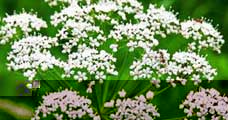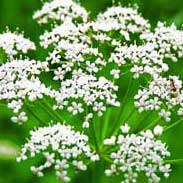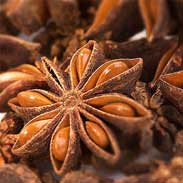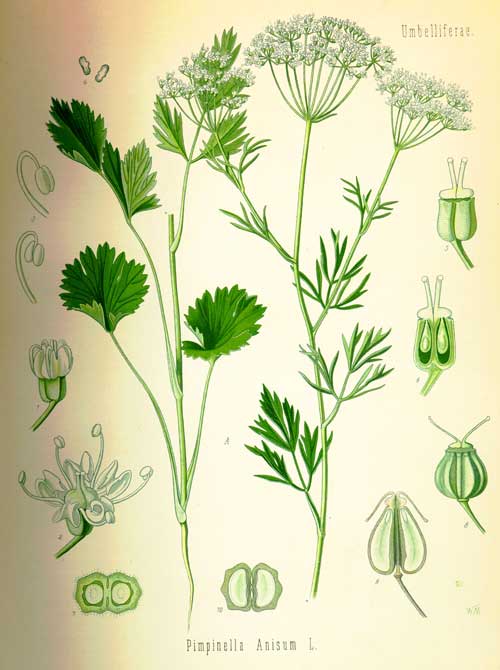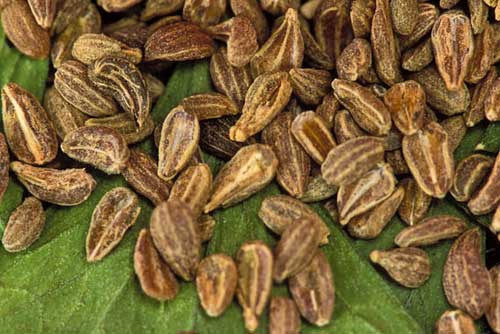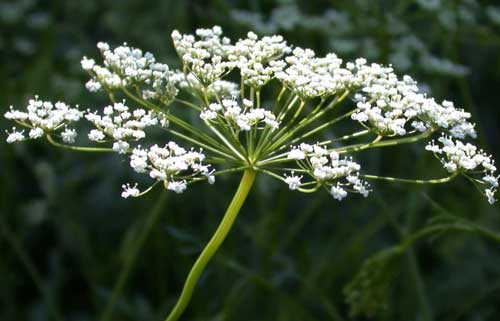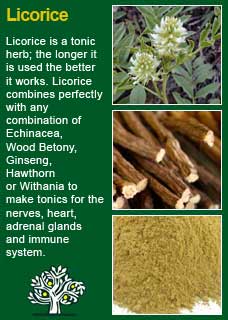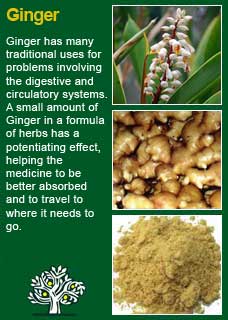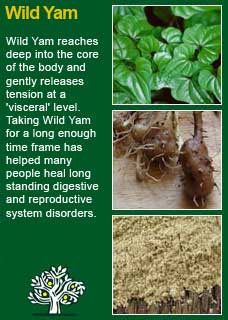
|
|
||||
| Our Pages ABOUT CONSTITUTIONAL MEDICINE
|
In herbal medicine we use the ripe, dried fruits of the Aniseed herb which can grow to over half a metre in its short year of life and, in the process, produce an umbrella shaped foliage with copious amounts of tiny, unmistakably strong-flavoured and scented fruits.
The U.S. Dispensary of 1918 writes 'Aniseed is one of the oldest aromatics, being used by the Egyptians and cultivated in the imperial farms of Charlemagne'. Aniseed is well known to many people as a confectionary, but less well known in modern times is just how central a place Aniseed used to occupy for coughs and colds. Hippocrates, the father of medicine, recommended Aniseed to help clear mucus from the respiratory system. Avicenna, in his Canon of Medicine, one of the most influential medical books in history, writes of Aniseed as heating and drying. He says 'it relieves against oedema and swellings of extremities and that the smoke arising from anise when placed on fire, gives relief against headache and vertigo. It facilitates the respiration and removes the obstructions of liver and spleen' M. Grieves writes 'Aniseed enjoys a considerable reputation as a medicine in coughs and pectoral affections. In hard, dry coughs where expectoration is difficult, it is of much value. Aniseed has a beneficial action on the bronchial tubes and for bronchitis and spasmodic asthma. The stimulant and carminative properties of Anise also make it useful in flatulency and colic.' Aniseed has been used as a key treatment to ease the torments of whooping cough in infants and the eclectic physicians of the 18th and 19th century used Aniseed for nausea, gas and infant colic. With respect to the effects of Aniseed, Rudolph Weiss describes it in relation to two other great carminative (gut-spasm reducing) herbs from the Umbelliferae family, Caraway and Fennel. 'The relative carminative strength of the plants, in decreasing order of potency, can be described as Caraway > Fennel > Aniseed. The expectorant (lung cleansing) potency of the herbs decreases in the reverse order. Hence Caraway has the strongest carminative potency and the lowest expectorant potency; the inverse is true of Aniseed and the potencies of Fennel lie in between the two.'
Aniseed was so popular in medieval England as a spice and medicine that King Edward I placed a special tax on it to raise money to repair the London Bridge. It was highly valued in Biblical times as well and was used instead of coin to pay taxes. In Matthew 23:23 it's written 'ye pay tithes of mint, anise and cumin' The famous Greek physician Theophrastus wrote that Aniseed, when kept by one's bed at night, brought sweet dreams with its sweet aroma. The Romans cultivated Aniseed extensively for its fragrance, flavour and medicinal properties and it was a key ingredient in 'mustaceum' a cake eaten as a digestive aid during Roman feasts. Historians consider mustaceum the forerunner of the modern wedding cake. ~ Constituents in Aniseed called anethol and methyl clavicol have been shown to be effective expectorants i.e. agents that promote the discharge of phlegm (Boskabady, M. H. and Ramazani-Assari, M. J Ethnopharmacol 2001;74(1):83-88) These same volatile oils have been shown to possess strong anti-microbial properties (Soliman, K. M. and Badeaa, R. I. Food Chem Toxicol 2002;40(11):1669-1675) ~ Anti-aging properties have been suggested from extracts from Aniseed that have demonstrated anti-elastase and anti-collagenase activity in vitro (Thring, T. S., Hili, P., and Naughton, D. P. Anti-collagenase, anti-elastase and anti-oxidant activities of extracts from 21 plants. BMC.Complement Altern Med 2009;9:27) ~ Possible anti-cancer effects are demonstrated by Anethole, a constituent of Aniseed, that has been shown to inhibit tumor necrosis factor (TNF)-induced NF-kappaB activation, IkappaBalpha phosphorylation and degradation, and NF-kappaB reporter gene expression in vitro (Chainy, G. B., Manna, S. K., Chaturvedi, M. M., and Aggarwal, B. B. Anethole blocks both early and late cellular responses transduced by tumor necrosis factor: effect on NF-kappaB, AP-1, JNK, MAPKK and apoptosis. Oncogene 6-8-2000;19(25):2943-2950) ~ Aniseed also contains substances dianethole and photoanethole, which share similar chemistry to the female hormone estrogen. Scientists suggest the presence of these substances probably accounts for the herb's traditional use as a milk promoter in nursing mothers (Tabanca, N., Khan, S. I., Bedir, E., Annavarapu, S., Willett, K., Khan, I. A., Kirimer, N., and Baser, K. H. Planta Med 2004;70(8):728-735). ~ A laboratory experiment showed that Aniseed extract increased the regeneration of damaged liver cells (Nureddin Cengiza Hanefi Özbekb, Aydın Him; Pharmacologyonline 3: 870-874 (2008) ~ The authors, titles and the 'where-and-when' published of nearly 400 further studies and articles on Aniseed are listed in a PDF found here
Some very preliminary research suggests that Aniseed might have some estrogenic effects so theoretically, the use of large amounts of the herb might interfere with the drug Tamoxifen, or oestrogen drugs or other contraceptive drugs through competition for estrogen receptors. That said, there is no reason to think that normal medicinal levels of Aniseed would pose any difficulties in this area.
For some years now, against this proven and safe way of herbalism, there has been a rising tide of excessive caution and scare-mongering in many parts of the world. The same authorities that, not so long ago, decried herbal medicines as ineffectual, have now taken up a different adversarial position; that they are dangerous substances that should only be prescribed by Doctors, who of course have zero training in them. Unfortunately, the same unnecessary fear and worry has crept into many natural health websites and popular publications on herbs. Herbs that we have safely used for thousands of years, that have no reports of adverse reactions in the medical literature despite widespread use by millions of people, are suddenly described as contraindicated because of something that should have been seen as completely unimportant, or at the utmost a merely theoretical concern, such as a laboratory study on one of the herb's constituents to use an all too common example. I wonder sometimes if the writers of such articles feel that the herb will be more deserving of respect if it is thought to be a little bit dangerous, in other words more like a drug than something that has simply come out of the earth and been used by ordinary people for generations beyond count. There is just so much misinformation about herbal medicine on the internet now. Ludicrous claims and cautions abound in equal measure; it seems like one group are trying to make money out of the public whilst the other are busily trying to scare them off. I have to believe that the kind of reader who takes the time to read pages on herbs that are as extensive as this one is much less likely to be swayed by marketers or misinformers. I hope that you will keep your wits about you if you get conflicting opinions from people who have never really got to know these herbs, who have never worked with them, or learned how to use them safely and effectively. I want to remind you that the reason that herbs can never be patented and owned by any individual or corporation is because they are, and always will be, the People's medicine. They belong to all of us and it is my great hope in sharing this work that you will learn how to use them wisely for yourself, and the people you care for. Be safe, but do not be afraid.
I think Aniseed can certainly be used as a medicine in its own right for congestive respiratory problems or constricted digestive complaints but I see a far broader use of Aniseed in terms of how it benefits the 'energetics' of other herbs with which it is blended and in how it opens up the 'breath'. If you have the opportunity to observe a child's breathing whilst they are asleep you will get a sense of how nature intended us to breathe: easily, slowly, deeply. In the rushing world of today most people do not breathe anywhere near as deeply or slowly as they need to, but rather in a shallow, hurried and tense manner. Over many years this leads to a host of problems in the way we take in the most vital of our nutrients (oxygen), in the way our hearts function and the way we feel. I have added a little Aniseed into my herbal formulas a great many times because a) only tiny amounts are required to improve the taste of the medicine and b) many people are too tight in their chests and in their breathing. The phenomenon of Aniseed was obviously not lost on the ancients, it is a truly healing herb. However, few people today realise what a potent ally we have with these tiny seeds. I'm not suggesting that Aniseed can cure such long-held habits of tightened breathing by itself but I would certainly say that it can help and a little Aniseed goes a remarkably long way. Even just a few drops of a tincture, taken regularly, will make a noticeable difference to how people carry tension in their lungs and gut. Aniseed has a marvellous relaxing and 'opening' effect on the whole respiratory system, starting with the nose and going right down to the bottom of the lungs. If you who are reading this are studying herbal medicine or have your own reasons to want to understand this plant ally at a much deeper level, then I warmly encourage you to take a cup of Aniseed tea or a small dose of its tincture and then, with a quiet and attentive mind, observe for yourself how it makes you feel. This old method of 'experiential' learning may give you a greater appreciation of the herb's 'action' than any amount of academic learning about it and I think you will be pleasantly surprised at just how certainly It will cause your breathing to deepen and your rate of respiration to slow! Further to this, if you would like to learn more about the ancient art of pulse testing, a simple but powerful way to ask the intuitive intelligence of the body for its responses to a herb by feeling the pulse whilst giving a tiny dose by mouth, read here Only small amounts of Aniseed are needed to achieve strong effects. Just a quarter (5 drops) to a ml (20 drops) of the tincture, which we make as a 1:5 in 40% ethanol (with organic seed from Egypt at time of writing!) Or just one-half to one gram of the seeds in a tea that has been well covered while it brews. A little goes a long way and this is a herb that is better to gently nudge into the body rather than use overly large doses that might create some resistance or even aversion. Aniseed combines perfectly with Peppermint and Ginger for a person with a bloated gassy stomach and with Lobelia, Mullein, Elecampane, Licorice and White Horehound for coughs, respiratory congestion and constriction. Some sample formulas to show these combinations in 'action', so to speak are just below.
To make 50 mls. Bearing in mind that these would be tinctures that we make in our clinic, therefore herbal extracts from other companies or practitioners might have a different range, the dose I would give for a sure action to release spasm or tension in the gut, or to relieve nausea, bloating etc, would be 5-10 drops for a child and 15-20 drops for an adult. Diluted if needed or taken straight if preferred and used as freely and frequently as needed to achieve a rapid relief of the symptoms.
To make between 200 and 210 mls depending on the amount of Lobelia. Less Lobelia for a child or a sensitive person, more for an adult or someone with a more robust system. To ease coughs, congested lungs, difficulty breathing etc. this formula could be given from 2 to 5 mls up to 4 or 5 times a day depending on the age and severity of the condition. Expect more coughing at first, and more cleansing of the lungs, followed by easier breathing and significant relief if it is being used often enough.
Much of the information here about the traditional uses of Aniseed is consistent with the model of thinking whereby one may treat problem A with plant B. There is value in this approach, especially in how it helps us pass on useful knowledge to one another, but it falls short in one vital area; and that is that people are not all cut from the same cloth! Something that works brilliantly for one person may do less for another -- why is this? Part of the reason is that people vary in their constitutions as to whether they are either hotter or cooler and, at the same time, either dryer or damper. This useful and rather fascinating subject is introduced further here Another big part of using the right herb when it is most needed comes from understanding the need to treat what is going wrong for the person that had led up to their getting a health condition. In this light, Aniseed shows itself as a warming, nourishing herb that can particularly offer its benefits when a relaxing action is needed in the 'cycle of healing' - more about that here
Please understand that I cannot advise you, including on products or dosage, without seeing you in person in my clinic but for ideas
on how you might find a good herbalist in your area read here |
|
|
© 2011 R.J.Whelan Ltd
